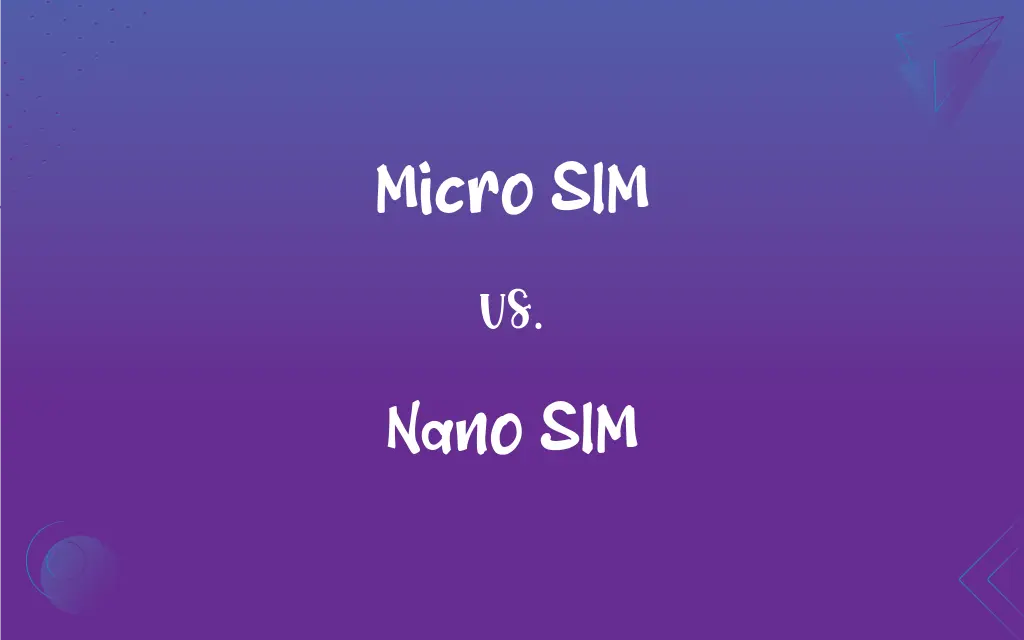Micro SIM vs. Nano SIM: What's the Difference?
Edited by Aimie Carlson || By Harlon Moss || Updated on October 12, 2023
Micro SIM and Nano SIM are types of SIM cards, distinguished mainly by size: Micro SIMs are larger (15x12mm) than Nano SIMs (12.3x8.8mm).

Key Differences
The Micro SIM card was designed with a size of 15x12 mm, becoming a standard for some time, while the Nano SIM card followed, having smaller dimensions at 12.3x8.8 mm, representing the effort to save space inside mobile devices. Both have respective slots in devices, indicating compatibility.
In the journey towards miniaturization, the Micro SIM card was introduced after the traditional Standard (or Mini) SIM card, becoming prevalent in numerous devices. The Nano SIM, on the other hand, arrived after, marking itself as the smallest SIM card format used in more contemporary gadgets.
Micro SIM cards can be adapted to fit standard SIM slots with the help of adaptors, enhancing its adaptability across devices. Conversely, Nano SIM cards, while also adaptable to larger sizes, demonstrate a prominence in the latest technology, considering its minuscule stature.
While differing in physical sizes, both the Micro SIM and the Nano SIM perform identical functional roles, such as storing user identification, contact information, and network authentication data. Thus, the disparity lies predominantly in their physical design and not in functional capacity.
Device manufacturers have adopted Micro SIM and Nano SIM cards, considering the overall design and internal space optimization of the devices. The Nano SIM, with its petite size, permits manufacturers a little extra room to incorporate other technological elements or enhance device slimness.
ADVERTISEMENT
Comparison Chart
Dimensions
15x12 mm
12.3x8.8 mm
Generational Order
Introduced after Standard SIM
Introduced after Micro SIM
Predominant Use
Common in older smartphones & tablets
Common in current smartphones & tablets
Adaptor Use
Can be adapted to Standard SIM
Can be adapted to Micro or Standard SIM
Physical Alteration
Requires cutting to convert to Nano
No need to cut to convert to Micro
ADVERTISEMENT
Micro SIM and Nano SIM Definitions
Micro SIM
Micro SIMs can be cut down to Nano SIM size, albeit with a risk of damaging the card if not done precisely.
Transitioning to a newer phone model, I cut my Micro SIM carefully to fit the Nano SIM slot.
Nano SIM
A Nano SIM is the smallest available format of SIM card, commonly used in modern mobile devices.
The smartphone utilizes a Nano SIM to store contact information and access the cellular network.
Micro SIM
Though replaced largely by Nano SIMs, Micro SIM cards are still applicable and used in various devices.
Despite technological advances, my tablet still operates using a Micro SIM to connect to mobile networks.
Nano SIM
Nano SIMs often necessitate adapters to fit into devices designed for larger SIM card formats.
I inserted my Nano SIM into an adapter to use it in a device that requires a Micro SIM.
Micro SIM
Micro SIM cards often need an adapter when used in devices designed for standard SIMs.
To use my Micro SIM in an old phone, I purchased an adaptor to ensure a secure fit.
Nano SIM
Cutting larger SIM formats to a Nano SIM size should be approached with caution to avoid data loss.
Carefully trimming the Micro SIM along the guide marks converted it into a Nano SIM for my newer smartphone.
Micro SIM
The Micro SIM offers similar functionalities as its predecessors and successors, enabling network accessibility in mobile devices.
Although smaller than traditional SIM cards, the Micro SIM holds my contacts and network access data efficiently.
Nano SIM
Despite its small size, a Nano SIM holds essential information like its larger counterparts.
The Nano SIM securely stores my phone number and subscriber identity for network usage.
Micro SIM
A Micro SIM is a smaller variation of a standard SIM card, used to store user data and authenticate network services.
My new phone requires a Micro SIM, so I had to change my standard one.
Nano SIM
Nano SIMs serve to authenticate the user's mobile service subscription, enabling communication services.
Without a Nano SIM, your device will be unable to make calls, send texts, or use mobile data.
FAQs
What is a Nano SIM?
A Nano SIM is the smallest SIM card format, widely used in the latest mobile devices for user identification and network access.
Can a Micro SIM fit into a Nano SIM slot?
No, a Micro SIM cannot fit into a Nano SIM slot without being physically cut to a smaller size.
Do all mobile operators offer Nano SIMs?
Most mobile operators provide Nano SIMs due to their commonality in modern devices.
Is there a price difference between Micro and Nano SIMs?
Typically no, but check with your mobile operator for precise details.
Which devices commonly use Nano SIMs?
Nano SIMs are widely used in newer smartphones and smart devices.
Is it easy to manually cut a Micro SIM into a Nano SIM?
It’s achievable with guidance, but risks, such as misalignment or damaging the chip, are present.
What is a Micro SIM?
A Micro SIM is a mid-sized SIM card, smaller than a Standard SIM and larger than a Nano SIM, used in mobile devices.
Can I cut my Micro SIM into a Nano SIM?
Yes, but it must be cut precisely to avoid damaging the SIM’s functional parts.
Can I convert my Nano SIM into a Micro SIM?
Yes, using an adapter, you can insert a Nano SIM into a Micro SIM slot.
Which devices commonly use Micro SIMs?
Micro SIMs are often used in older smartphones and some tablets.
Is the conversion from Nano SIM to Micro SIM reliable?
Generally yes, using a proper adapter should make the conversion reliable.
Do Micro SIMs and Nano SIMs have different speed capabilities?
No, speed is determined by the network and device, not the SIM card size.
Can I request a Nano SIM from my operator if my current SIM is larger?
Yes, operators usually provide SIM replacements, possibly for a fee.
Will changing my Micro SIM to a Nano SIM change my number?
No, the number remains the same; only the SIM size changes.
Is the functional aspect different between the two?
No, both Micro SIM and Nano SIM perform similar functions like user authentication and data storage.
Is there a data storage difference between them?
No, both SIM types can store user identity, contact information, and network authentication details.
Can I switch my SIM between different devices?
Yes, provided the devices accept the SIM size or an adapter is used.
Can a Nano SIM be used in a Micro SIM slot?
Yes, but it requires an adapter to fit properly in a Micro SIM slot.
Will cutting a Micro SIM to a Nano SIM size void its functionality?
Not if cut correctly, but errors in cutting could damage it and render it useless.
Can I recover data from a damaged Micro or Nano SIM?
Recovery can be complex and is not always possible; contact your operator for assistance.
About Author
Written by
Harlon MossHarlon is a seasoned quality moderator and accomplished content writer for Difference Wiki. An alumnus of the prestigious University of California, he earned his degree in Computer Science. Leveraging his academic background, Harlon brings a meticulous and informed perspective to his work, ensuring content accuracy and excellence.
Edited by
Aimie CarlsonAimie Carlson, holding a master's degree in English literature, is a fervent English language enthusiast. She lends her writing talents to Difference Wiki, a prominent website that specializes in comparisons, offering readers insightful analyses that both captivate and inform.































































